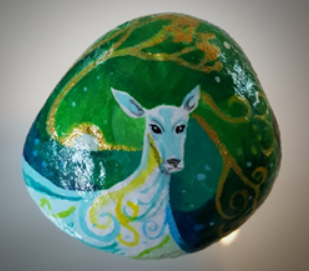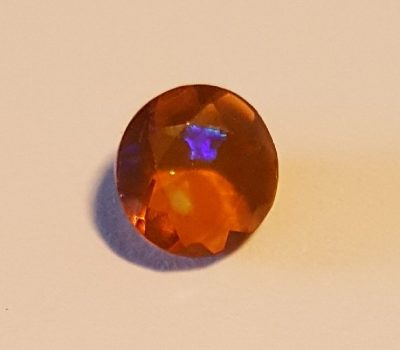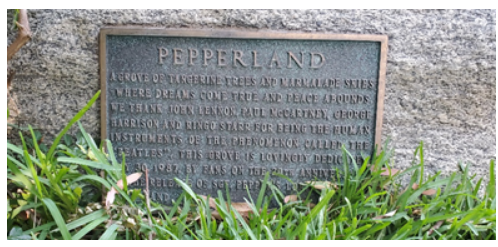Congrats to Kristopher P, Nadine C. and Bradley H.!
SOLUTION FOR GARNER, NORTH CAROLINA, WHITE DEER PARK, along trail, behind trees (This is right outside of Charlotte, NC)
Call her Virginia, shall we dare? = There is a legend that Virginia Dare was turned into a white deer
This beauty, magnificent, elusive and rare. = A white deer is said to be beautiful, elusive and rare.
Run down and felled, = The white deer of Garner was hit by a car
Her spirit not quelled. = Locals had the deer sent to a taxidermist
Brought back from the dead, then caught on fire. = After being put on display, vandals set the deer on fire
This messenger from the other world cannot expire. = White deer are known as messengers from the past (See
en.wikipedia.org/wiki/Deer_in_mythology)Twice, her ghost has been resurrected. = Called a “ghost” because the deer is all white. The locals keep repairing the deer, once after being hit by a car; the second time after being put on fire
Now, behind glass, she stands, protected. = The deer is now on display, but behind glass with alarms
Search the triangle for what to claim. = Garner is within the Charlotte, NC “Triangle” area
If you are near this rare beauty, = rare albino deer, in the Garner area, in White Deer Park
You might win this game. = You just have to find the proxy to win. It can be found near this taxidermized deer.
From the park’s website:
www.garnernc.gov/departments/parks-recreation-and-cultural-resources/parks-facilities/parks/white-deer-park/park-informationThe park was named for an albino doe that said to have roamed the forests and fields around Lake Benson Park.
From local news articles about the deer:
The simply named "White Deer," a 2-year old albino deer adopted by the town of Garner as a mascot, was killed when struck by an automobile in late 2001. In November 2002, she reappeared in town -- stuffed and on exhibit at Old Garner High School. She's since moved on to a temporary stint at the North Carolina Museum of Natural Sciences, Raleigh, NC.
A 96-acre park in Garner named "White Deer Park" may become permanent home of the stuffed albino in a plexiglass display -- if locals can raise the money and figure out how to prevent bucks from charging it during mating season.
[11/30/2002]
Garner North Carolina's "White Deer" was set on fire by unknown criminals at 4 am Friday, June 10, according to local news accounts. The stuffed albino doe was a town mascot that became even more beloved after her death from an automobile encounter in 2001. Only last week the dedication was held for a new building, called the "Little Storytelling House," where the White Deer was installed for public enjoyment at Lake Benson Park.
The vandals pulled the animal out of the "Little Storytelling House," placed straw underneath, and set the White Deer ablaze. Townspeople have already raised $1,500 offered as a reward to capture the White Deer arsons. There is also talk of attempting to restore the deer hide, which was principally damaged on one side.... [Update: The White Deer has been repaired and is back on display]
Update - July 15, 2005: The deer has been repaired by a taxidermist and is back in its building, which is equipped with motion detectors and perimeter lights to discourage albino deer molesters. [Thanks to Dean Jeffrey for the tip]
[06/10/2005]
There is a legend that claims Virginia Dare was turned into a white deer. You can read about it here:
northcarolinaghosts.com/coast/virginia-dare-white-doe/And here is another version if you are interested in reading about it:
boyscouttrail.com/content/story/white_deer_named_virginia_dare-3.aspAlong the bay islands, where the pale people set up their first permanent settlement, there was born a child, the one known as Virginia Dare. And the people of the islands, the Chesapeake people, called the newborn White Fawn. Around the pine-speckled islands and sea-grass peninsulas, her story was told. It said that upon the child's death, her spirit would assume the form of a frosted fawn whose face, because her race had come from across the sea, would always gaze wistfully in that direction, as if yearning for that faraway shore. The story went on to say that if ever a runner should catch the fawn after she was fully grown into a white deer and shoot her with an arrow whose head was cast of silver, this would restore her to mortal form.
Now, the far banks and islands of coasts, not often met by travelers, were home to the Hatteras people, but the long salt-bitten winters presided over by hungry moons separated them from their pale friends, and in time, they lost touch with one another. One autumn day, a hunter named Little Oak came upon some ruined, abondoned log houses in the saw grass of the settlement of Roanoke. There were no pale people living there anymore; the berry brambles and rose hips had grown up between the cracks of the wind-washed logs. Slow autumn turtles lay by the cold hearthsides of cracked ashen clay. All that the hunter named Little Oak could find was an old baby's rattle, clutched by the claws of a rose thorn. Then he spied a beautiful white doe. By instinct, he drew his bow, but he would not let the arrow loose, holding it in check, the barred turkey feathers itching at his ear.
Time passed and the white doe was well known amoung the hunters of Roanoke Island. Often she was seen browsing amid the brown herd of deer that lived there. But she always remained apart, turning her head to the east, sad-eyed and dreaming on the direction of the distant sea. Those who were compelled to hunt her said that their arrows, though well-aimed, fell harmless at her hooves...whereupon she would leap with the west wind, swift as milkweed down, bounding the sand hills, driving the quick curlews and iron-winged cranes up into the cold gray, slate-colored sky.
Talk of the white doe flowed like a river tumbling from its source in the clefted rocks; it went various ways. Some of the people had fear of the animal, thinking her spirit was one of desolation. They said none but the spirit deer could travel the high grassy grounds od Croatan and yet the same day be seen in the cranberry bogs of East Lake.
Always sad, head ever turned toward the eastern-glinting sea, always beautiful, always a little apart, the white doe danced in a dream of her own making. Then, early one autumn, the people of the islands decided what to do: They would hold a great deer hunt, and all the finest bow hunters would be invited to join in. Afterward, there would be a feast and celebration. Now the plan, they say, was to hunt the milk white doe. If any runner or hunter...and all the best were gathered there...could bring her down with an arrow, then all would know if she was flesh or spirit; and, thereafter, if she should prevail, then no one would ever go after her again. It was thus decreed, and the hunt and race was on. Some took to the high sunburned mounds above the sound; some went to the low thistle meadows of the flat ocean islands. Hunters and runners alike spread out like a peat fire across good ground, quaking ground, low ground and high; and the bird-swept prairies rang with their chants. The best bows were drawn and the straightest arrows nocked. Only one hunter, however, had an arrow with a cast-silver tip that had come from over the sea from the island known as England...a silver arrow point given, they say, by the great queen herself. This was a thing that could, it was told, reach the heart of even the most charmed lives.
And it happened that the swift doe was chased from the rank grass of the shaky land; a bowstring's angry twang sent her flying on the north wind's breath. Through tangled wood and trailless bog, through morass and highland, she sped. And the myriad bowstrings made the sounds of harmless bees in the wake of her whiteness. She plunged on through the billows of the sound, reaching the sand hills on Roanoke. Here, she stood atop the ruins of the old fort, gray-logged and silvery-splintered, breathing the easternmost breeze from afar, panting, her small tongue flickering like a pink petal. Now, in the deep, wind-blown grass, Little Oak appeared, took aim at the glowing form before him, and let loose the fated bowstring that burned the air and sent the silver-headed arrow on an irretrievable mission. The beautiful sad-eyed doe leapt, heart pierced, into the air and sank desparately to the ground. Then Little Oak threw down his bow, ran to her side, lifted the head of snow, soft as a cloud, looked into the dying eyes, and saw, suddenly, the face of a pretty young woman, who, through dry, heart-spent lips, whispered her name, Virginia Dare, and died.
So goes the story. And the lost Virginia Dare, what of her? Did she die in infancy? Did her child bones mingle with the dust of her legend and blossom in the wild roses of Croatan? Did she ever grow to womanhood? Did she end her life in whatever darkness that still enshrouds the lost pale colony that vanished into the deep mists?
IN THE ART:
The art obviously shows a white deer, for White Deer Park.
Along the trail in the park are culverts, which were painted green, and footprints were added for the animals in the area. Between the culvert for the fox and the deer, is the tree pictured in the art. Below the tree, in the green border of the art, it reads, "tree" and the "T" is made into an arrow pointing to the very tree where the proxy item is hidden. It was behind that tree!
The Proxy:

The Gemstone:















